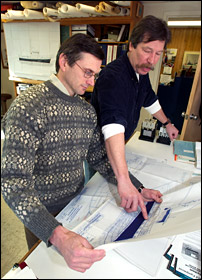
|
 |
Research > Research
Departments > Applied Ocean Physics & Engineering
Applied Ocean Physics & Engineering
Overview | Awards
& Recognition | Photos
 |
 |
| Rocky Geyer,
chair of the AOPE Department (left) discusses the Institutionís
new coastal research vessel with Port Engineer Dutch Wegman.
They were instrumental in the design of Tioga,
which can range from the Gulf of Maine to New York harbor.
(Photo by Tom Kleindinst) |
The engineers, scientists, and technicians of the Applied Ocean
Physics and Engineering Department (AOPE) seek novel ways to
observe and model ocean processes, extending the reach of the
oceanographic community from the turbulent surf zone to the
abyssal depths. Research and development in the department can
be divided into five areas: environmental fluid mechanics, ocean
acoustics, submersible vehicles, observing systems and sensors,
and engineering services.
The departmentís Deep Submergence Laboratory
made strides in 2003 to take science deeper into
the abyss. In December, the National Science
Foundation, the U.S. Office of Naval Research
(ONR), and the National Oceanic and Atmospheric
Administration granted Dana Yoerger, Andy Bowen, and Louis Whitcomb $5 million to build a hybrid
remotely operated vehicle (HROV) capable of exploring the deepest trenches of the ocean. Part
autonomous free-swimming robot, part tethered
vehicle, the HROV will combine wide-area survey
capabilities with close-up sampling.
Chris von Alt and Ben Allen of the Oceanographic Systems Laboratory
put different versions of their Remote Environmental Monitoring
UnitS (REMUS) to work for the U.S. Navy and the City of New
York. In the spring, REMUS vehicles were used to detect mines
in the Iraqi harbor of Um Qasr. In early summer, the Tunnel
Inspection Vehicle, a specially designed REMUS, surveyed the
decaying New York City aqueduct system to locate leaks.
Hanumant Singh and colleagues used the SeaBED autonomous vehicle
to discover previously unmapped coral communities thriving at
intermediate depths off the U.S. Virgin Islands. Using specially
outfitted camera systems, the team found corals in regions beyond
the reach of divers and most observing systems.
John Trowbridge and Jim Edson led the design, deployment, and
instrumentation of an AirSea Interaction Tower (ASIT) about
three kilometers south of Marthaís Vineyard. The tower is connected
to shore-based labs via the Marthaís Vineyard Coastal Observatory.
As part of ONRís Coupled Boundary Layers/Air-Sea Transfer (CBLAST)
program, scientists from six institutions used an array of off
shore moorings, aircraft and ship-based surveys, as well as
the highly instrumented ASIT, to gather data that will improve
models of the coupling between the ocean and atmosphere and
could improve marine forecasts.
Along the California coast, Senior Scientist Steve Elgar and
Associate Scientist Britt Raubenheimer led a team of 25 scientists
from 10 institutions in the Nearshore Canyon Experiment (NCEX).
From September through December, the NCEX team deployed arrays
of instruments to observe how submarine canyons and other seafloor
formations affect wave propagation and nearshore currents (see
Doing the Wave).
—W. Rockwell Geyer (rgeyer@whoi.edu)
Department Chair
|
|
